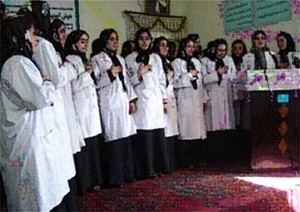Home » Reports & Data » Progress » Transforming Lives » Afghanistan’s Next Generation Gets a Helping Hand from Community Midwives

Newly graduated midwives in Badakshan Province take the Midwives Pledge.
USAID/Afghanistan
Training midwives in rural areas.
30 DECEMBER 2008 | KABUL, AFGHANISTAN
Afghanistan has the world’s second highest maternal mortality ratio. Every 27-30 minutes a woman dies from causes related to pregnancy or childbirth. Because this is such a grave health concern, USAID and the Government of the Islamic Republic Afghanistan are committed to training midwives across the country. In spring 2008, 115 community midwives graduated from midwifery education programs in five provinces, including Khost, Bamyan, Badakshan, Takhar and Jawzjan.
USAID contributed funding and technical assistance to the midwifery education programs. The midwives were recruited with support from their communities, and, following a rigorous selection process, received an 18-month period of education. They were trained with a new midwifery curriculum designed by the Afghanistan Ministry of Public Health. As a result of this training, the midwives are now equipped with the skills to provide pregnant women and their babies with desperately needed maternity care.
The skilled midwives will be deployed back to the communities that selected them and will work from health facilities, some of them in very remote areas. “We are ready to start working to improve the health of Afghan women and babies. We have been trained in the skills we will need to work as midwives. I know I will be working alone but my community will support me”, said one graduating midwife.
Minister of Public Health Dr Sayed Amin Fatamie noted, “These midwives literally hold the future of Afghanistan in their hands; without skilled care during delivery women in Afghanistan will continue to suffer.”
With financial and technical support from the Government of the Islamic Republic of Afghanistan, USAID and others, there are now a total of 18 community midwifery schools. USAID supports seven of these programs, all of which are accredited by the National Midwifery Education Accreditation Board to ensure they maintain high professional standards.







Comment
Make a general inquiry or suggest an improvement.